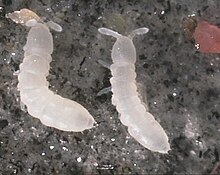Edaphone
As soil organisms or Edaphon (from the Greek edaphos "ground") is the totality of the soil living organisms (soil organisms and soil micro-organisms), respectively. In contrast to this, the associated adjective edaphic means “concerning the soil” or “concerning the ecological effect of the soil”. The term was coined at the beginning of the 20th century by the botanist and microbiologist Raoul Heinrich Francé .
Classification

The soil organisms are traditionally divided into plant ( soil flora ) and animal ( soil fauna ). Numerous single or few cell eukaryotic microorganisms , the protists, live in the soil . In addition to plant and animal species, they also include mushrooms.
Depending on the habitat, it is also divided into:
- hyperedaphic - living in the herb layer
- epedaphic / epigeic - living in the scattered layer
- hemaphic / hypogean - living in humus layer
- euedaphic / endogean - living in the (upper) soil
Soil flora
The soil flora consists of fungi , algae , bacteria and lichens , among other things . Bacteria in particular feed mainly on dead, organic matter. The soil flora plays an important role within the ecosystem due to this humification and mineralization of the organic material . Plant roots do not belong to the soil flora.
Based on the term nanoplankton , Francé called the autochthonous microflora the nanedaphon . This contains different rod, club and cocci shapes , which may change cyclically, but are present in all earthly climates . It is a "deep form" of the Edaphon, as this microflora needs the least light and air and is often found at a depth of one meter.
Soil fauna
Just like the soil flora, the soil fauna also plays an important role through the crushing and decomposition of dead plant remains and animal corpses. In particular, soil crawlers and diggers ensure mixing, aeration and loosening of the soil.
Subdivision by size:
- Microfauna (<0.2 mm): amoebas , ciliates , roundworms
- Mesofauna (<2 mm): mites , springtails
- Macrofauna (<20 mm): woodlice , spiders , earthworms , beetles and other insects
- Megafauna (> 20 mm): vertebrates such as moles , voles and shrews
The microfauna takes on the function of mineralization. The mesofauna ensures small-scale bioturbation , litter fragmentation and bioaccumulation . Macro and megafauna ensure large-scale bioturbation, litter fragmentation and aggregate formation. In addition, all components of the soil fauna promote microbial activity.
Subdivision according to typical movement behavior:
composition
The entirety of the organisms living in the soil play an important role in the composting process. The following values are only approximations and may vary depending on the type of soil:
- 40% bacteria , especially actinomycetes
- 40% algae and mushrooms
- 12% earthworms
- 5% other macrofauna: polychaetes, gastropoda, arachnida ...
- 3% other microfauna: nematodes, mites , collembola ...
See also
literature
- Annie Francé-Harrar : Humus. Soil life and fertility . Bayerischer Landwirtschaftsverlag, Bonn et al. 1957.
- Raoul Heinrich Francé : Life in the ground. The edaphone. New edition. Edition Siebeneicher, Deukalion Verlag, Hamburg 1995, ISBN 3-930720-02-7
- Zdenek Filip: Influence of chemical contaminants (especially heavy metals) on soil organisms and their ecologically important activities. In: UWSF - Zeitschrift für Umweltchemie und Ökotoxikologie 7, 2, (1995), ISSN 0934-3504 , pp. 92-102.
Web links
- www.ahabc.de the magazine for soil and garden: life in soil clearly described.
- Video Who lives in our forest floor? on www.forstcast.net
